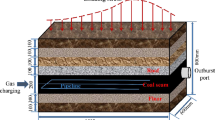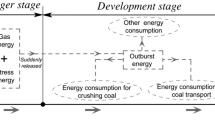Abstract
Coal–gas outburst is a complex dynamic phenomenon in underground coal mines that has occurred frequently over the past 150 years. This phenomenon has seriously restricted the efficient development of coal resources and it poses a great threat to global energy security. Physical simulation experiments under different conditions that considered the coal–rock combination structure and gas adsorptivity were carried out by using a true triaxial coal–gas outburst experimental system, and the experiments controlled for the type of adsorbable gas, the presence (or absence) of a roof and the gas pressure. The influence of the coal–rock structure and gas adsorptivity on the disaster occurrence conditions and dynamic response characteristics was discussed, and the gas–solid-coupling disaster-inducing mechanisms of coal–gas outburst under unloading were obtained. The results show that outburst pulverized coal does not present an obvious sorting performance under the experimental conditions of this work. All the outburst holes are characterized by small openings and large cavities. Coal walls around the holes are damaged by spallation, and the strength of the outburst holes is low, but relatively stable. Stronger gas adsorptivity and greater gas pressure correspond to more intense outburst dynamic effects. Moreover, greater outburst intensity corresponds to more obvious coal spallation characteristics. Whether there is roof or not has no significant effect on the sweeping and handling of thrown pulverized coal. Compared with the condition without roof, the existence of a roof will promote an increase in the outburst intensity and more obvious spallation damage of the outburst coal. The coal–gas outburst process includes four stages: outburst occurrence, rapid development, deceleration development and outburst termination. The research results have certain guiding significance for studies on the mechanism of coal–gas outburst.












Similar content being viewed by others
References
Aguado, M. B. D., & Nicieza, C. G. (2007). Control and prevention of gas outbursts in coal mines, Riosa–Olloniego coalfield, Spain. International Journal of Coal Geology,69(4), 253–266.
Alexeev, A. D., Revva, V. N., Alyshev, N. A., & Zhitlyonok, D. M. (2004). True triaxial loading apparatus and its application to coal outburst prediction. International Journal of Coal Geology,58(4), 245–250.
An, F. H., Cheng, Y. P., Wang, L., & Li, W. (2013). A numerical model for outburst including the effect of adsorbed gas on coal deformation and mechanical properties. Computers and Geotechnics,54, 222–231.
An, F., Yuan, Y., Chen, X., Li, Z., & Li, L. (2019). Expansion energy of coal gas for the initiation of coal and gas outbursts. Fuel,235, 551–557.
Beamish, B. B., & Crosdale, P. J. (1998). Instantaneous outbursts in underground coal mines: an overview and association with coal type. International Journal of Coal Geology,35(1–4), 27–55.
Chen, K. P. (2011). A new mechanistic model for prediction of instantaneous coal outbursts—dedicated to the memory of Prof. Daniel D. Joseph. International Journal of Coal Geology,87(2), 72–79.
Chen, X., Li, L., Wang, L., & Qi, L. (2019). The current situation and prevention and control countermeasures for typical dynamic disasters in kilometer-deep mines in China. Safety Science,115, 229–236.
Fan, C., Elsworth, D., Li, S., Chen, Z., Luo, M., Song, Y., et al. (2019). Modelling and optimization of enhanced coalbed methane recovery using CO2/N2 mixtures. Fuel,253, 1114–1129.
Golshani, A., Oda, M., Okui, Y., Takemura, T., & Munkhtogoo, E. (2007). Numerical simulation of the excavation damaged zone around an opening in brittle rock. International Journal of Rock Mechanics and Mining Sciences,44(6), 835–845.
Hanes, J., Lama, R. D., & Shepherd, J. (1983). Research into the phenomenon of outbursts of coal and gas in some Australian collieries. In 5th ISRM Congress. International Society for Rock Mechanics and Rock Engineering.
Jiang, C., Xu, L., Li, X., Tang, J., Chen, Y., Tian, S., et al. (2015). Identification model and indicator of outburst-prone coal seams. Rock Mechanics and Rock Engineering,48(1), 409–415.
Jin, K., Cheng, Y., Ren, T., Zhao, W., Tu, Q., Dong, J., et al. (2018). Experimental investigation on the formation and transport mechanism of outburst coal–gas flow: Implications for the role of gas desorption in the development stage of outburst. International Journal of Coal Geology,194, 45–58.
Li, H., Feng, Z., Zhao, D., & Duan, D. (2017). Simulation experiment and acoustic emission study on coal and gas outburst. Rock Mechanics and Rock Engineering,50, 2193–2205.
Liu, H., Lin, B., Mou, J., & Yang, W. (2019a). Mechanical evolution mechanism of coal and gas outburst. Rock Mechanics and Rock Engineering,52(5), 1591–1597.
Liu, H., Lin, B., & Yang, W. (2019b). Theoretical models for gas adsorption-induced coal deformation under coal seam field conditions. Energy Science and Engineering,7(5), 1504–1513.
Liu, J., Zhang, R., Song, D., & Wang, Z. (2019c). Experimental investigation on occurrence of gassy coal extrusion in coalmine. Safety Science,113, 362–371.
Otuonye, F., & Sheng, J. (1994). A numerical simulation of gas flow during coal/gas outbursts. Geotechnical and Geological Engineering,12(1), 15–34.
Pan, Z., & Connell, L. D. (2007). A theoretical model for gas adsorption-induced coal swelling. International Journal of Coal Geology,69(4), 243–252.
Rossmanith, H. P. (1983). Rock fracture mechanics. Vienna: Springer.
Skoczylas, N. (2012). Laboratory study of the phenomenon of methane and coal outburst. International Journal of Rock Mechanics and Mining Sciences,55, 102–107.
Sobczyk, J. (2014). A comparison of the influence of adsorbed gases on gas stresses leading to coal and gas outburst. Fuel,115, 288–294.
Tu, Q., Cheng, Y., Guo, P., Jiang, J., Wang, L., & Zhang, R. (2016). Experimental study of coal and gas outbursts related to gas-enriched areas. Rock Mechanics and Rock Engineering,49(9), 3769–3781.
Tu, Q., Cheng, Y., Liu, Q., Guo, P., Wang, L., Li, W., et al. (2018). Investigation of the formation mechanism of coal spallation through the cross-coupling relations of multiple physical processes. International Journal of Rock Mechanics and Mining Sciences,105, 133–144.
Wang, C., Yang, S., Yang, D., Li, X., & Jiang, C. (2018). Experimental analysis of the intensity and evolution of coal and gas outbursts. Fuel,226, 252–262.
Wang, G., Li, W., Wang, P., Yang, X., & Zhang, S. (2017a). Deformation and gas flow characteristics of coal-like materials under triaxial stress conditions. International Journal of Rock Mechanics and Mining Sciences,91, 72–80.
Wang, K., Du, F., Zhang, X., Wang, L., & Xin, C. (2017b). Mechanical properties and permeability evolution in gas-bearing coal–rock combination body under triaxial conditions. Environmental Earth Sciences,76(24), 815.
Wold, M. B., Connell, L. D., & Choi, S. K. (2008). The role of spatial variability in coal seam parameters on gas outburst behaviour during coal mining. International Journal of Coal Geology,75(1), 1–14.
Xu, T., Tang, C. A., Yang, T. H., Zhu, W. C., & Liu, J. (2006). Numerical investigation of coal and gas outbursts in underground collieries. International Journal of Rock Mechanics and Mining Sciences,43(6), 905–919.
Xue, S., Wang, Y., Xie, J., & Wang, G. (2011). A coupled approach to simulate initiation of outbursts of coal and gas—model development. International Journal of Coal Geology,86(2–3), 222–230.
Xue, S., Yuan, L., & Wang, J. (2015). A coupled DEM and LBM model for simulation of outbursts of coal and gas. International Journal of Coal Science & Technology,2(1), 22–29.
Xue, S., Yuan, L., Wang, Y., & Xie, J. (2014). Numerical analyses of the major parameters affecting the initiation of outbursts of coal and gas. Rock Mechanics and Rock Engineering,47(4), 1505–1510.
Yin, G., Jiang, C., Wang, J. G., Xu, J., Zhang, D., & Huang, G. (2016). A new experimental apparatus for coal and gas outburst simulation. Rock Mechanics and Rock Engineering,49(5), 2005–2013.
Yuan, L. (2016). Control of coal and gas outbursts in Huainan mines in China: A review. Journal of Rock Mechanics and Geotechnical Engineering,8(4), 559–567.
Zhang, C., Xu, J., Yin, G., Peng, S., Li, Q., & Chen, Y. (2018). A novel large-scale multifunctional apparatus to study the disaster dynamics and gas flow mechanism in coal mines. Rock Mechanics and Rock Engineering,52(8), 2889–2898.
Zhao, W., Cheng, Y., Jiang, H., Jin, K., Wang, H., & Wang, L. (2016). Role of the rapid gas desorption of coal powders in the development stage of outbursts. Journal of Natural Gas Science and Engineering,28, 491–501.
Acknowledgments
This research is financially supported by the National Natural Science Foundation of China (51874314, 51904310, 51704164), the Open Funds of Hebei State Key Laboratory of Mine Disaster Prevention (KJZH2017K02), the Chinese Postdoctoral Science Foundation (2019M660861), the Guizhou Science and Technology Support Program ([2017]2820), the Yue Qi Distinguished Scholar Project, China University of Mining & Technology, Beijing.
Author information
Authors and Affiliations
Corresponding authors
Rights and permissions
About this article
Cite this article
Du, F., Wang, K., Zhang, X. et al. Experimental Study of Coal–Gas Outburst: Insights from Coal–Rock Structure, Gas Pressure and Adsorptivity. Nat Resour Res 29, 2481–2493 (2020). https://doi.org/10.1007/s11053-020-09621-7
Received:
Accepted:
Published:
Issue Date:
DOI: https://doi.org/10.1007/s11053-020-09621-7




